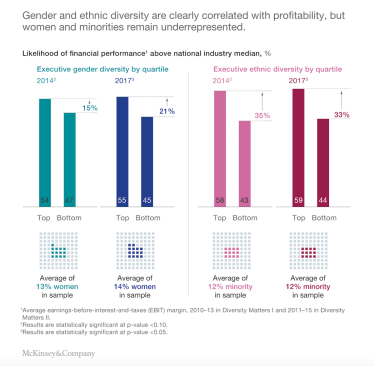Money talks.
When it comes to change–especially needed change to long-held, well-proven, time-tested strategic business practice–a new idea may come across as elegant, and advocates of new ideas may be eloquent and charismatic, and they may even be persuasive. The new idea may be compelling, but it will meet with a solid wall of resistance, skepticism, and belief that what’s worked well in the past will work best today and tomorrow.
However, money and action are the ultimate convincers, not words or ideas or a theory that some other way of doing things may be the right way, or smarter way, or better way.
“Diversity in our industry is ridiculously lacking–not just gender diversity, but in all its forms–in every piece of our business community,” Sherly Palmer, chairman, CEO and president of Taylor Morrison, whose two female directors on its board represent–percentage-wise–the most diverse of all the public home builder company boards. “Diversity changes the way our business culture works, changes how we think. And those differences in perspective give us greater insight into both our customers and our associates.”
Well, now money has begun to talk–loud, and forcefully–and it’s a question for home building enterprises, building products and materials suppliers, investors, and other organizations critical to the the flow of resources into residential development, design, engineering, and construction as to whether they hear it speaking to them. Or not.
Also, whether they’ll listen. Or not. If they do, it will change–fundamentally–some of those long-held, proven, time-tested practices, from the ground up to the corner office and beyond. And if they don’t?
Last week, in one of an important and increasingly frequent and meaningful series of such instances, money spoke loud and clear to corporations that are the beneficiaries of large state pensions that have become institutional investors in hundreds of American firms. Leadership of the $209.1 billion New York State Common Retirement Fund declared it will oppose companies in its investment portfolio that intend to re-elect all-male boards of directors. Wall Street Journal staffer Joann S. Lublin writes:
The New York pension fund owned shares in more than 400 U.S. businesses without any female directors last year.
The fund already has opposed or will soon oppose directors up for re-election at companies such as TransDigm Group Inc., Seaboard Corp. and Sonic Automotive Inc.
Now, earlier, Black Rock, with $6.3 trillion in investment assets it manages, and State Street, whose portfolio includes $2.47 trillion in assets, have each taken a stand to push for greater diversity on the boards of companies they invest in, each of them joining with other of the world’s most powerful financial assets management companies–Fidelity, Vanguard, Aberdeen, and others calling management directly to account for increasing the pace of diversification change and improvement in their governance practices, specifically around board composition.
As the WSJ notes, passive investors are an ever-more-powerful governance influence as investors “pour billions into lower-cost index-tracking funds like exchange-traded-funds.”
What’s more, both for the sake of creating a thicker stream of qualified candidates into board casting decisions, and strengthening an organization’s performance, companies in the home building space need to look at and improve gender and ethnic diversity at every level. WSJ staffer Vanessa Fuhrmans mines a recent McKinsey & Co. analysis of 1,000 companies for insights such as this:

“Companies with diverse executive teams posted bigger profit margins than their rivals, compared with companies with relatively little diversity in their upper echelons.”
This finding
“The chain of opportunity–or lack of it–starts early, in the staff ranks, mangement ranks, leadership ranks, right up through competence, qualification, and all the criteria essential to serve on a board,” says Taylor Morrison’s Sheryl Palmer. “If you don’t start developing that knowledge, experience, and demonstrated leadership early on, then it’s going to be no surprise that there are less qualified people in the potential pool of board directors. We have to take a more aggressive stance.”
Why all the fuss now about diversity? Is this big push playing out as it is because leaders of these mega capital investment organizations are promoting an altruistic social agenda? If this is at all the case, it’s only partially so. For according to several sources of data, more gender, ethnic, and cultural diversity at both the strategic leadership and the governance level improve companies’ value and performance, financial and operational, present and future.
Our research confirms that gender, ethnic, and cultural diversity, particularly within executive teams, continue to be correlated to financial performance across multiple countries worldwide. In our 2015 report, our hypotheses about what drives this correlation were that more diverse companies are better able to attract top talent; to improve their customer orientation, employee satisfaction, and decision making; and to secure their license to operate—all of which we believe continue to be relevant.
Companies report that materially improving the representation of diverse talent within their ranks, as well as effectively utilizing inclusion and diversity as an enabler of business impact, are particularly challenging goals. Despite this, multiple companies worldwide have succeeded in making sizable improvements to inclusion and diversity across their organizations, and they have been reaping tangible benefits for their efforts.
So, this “money talks” notion is less about political or social debate, and it’s more about business–good business.
Now, last week, it came to light that BMC Stock Holdings appointed Ashton Woods chief financial officer Cory Boydston to its nine-member board of directors, succeeding retiring director Barry J. Goldstein.
The move is significant not only because it adds a first-time board member–who happens to be female–to the board of a $3.4 billion (net sales) national player in the construction and materials distribution ecosystem as it carries on a search for a chief executive officer, but because home building and building materials and products companies are well below average in strategic and governance opportunity.
We asked Margaret Whelan, principal at Whelan Advisory LLC., and board solutions and data consultancy Equilar to help illustrate just how far below average the home building community is when it comes to gender diversity and inclusion on the governance front.
Be sure to scroll to view all table content. Peer Group Averages Equilar 500 Averages (as of 2017 proxies) Russell 3000 Averages (as of 2017 proxies)
The Equilar survey looks at 19 public home builder companiess, four of which have no women on their boards–AV, Century Communities, Hovnanian, and LGI. Among the 19 firms, seven have one woman on their boards–D.R. Horton, MDC*, Meritage, NVR, Toll Brothers, Tri Pointe, and William Lyon Homes. This leaves eight companies that have the maximum number of female directors, two.
Margaret Whelan observes that a deeper look at the Equilar data on home building public enterprises not only explains the virtually across-the-board lack of diversity, but reveals other patterns on the boards that could easily put the companies out of touch with key stakeholders, investors, consumers, and a much-needed new talent stream.
“Builder boards on average have 9 members, 20% less than the Equilar 500 Average of 11 board members,” notes Whelan. “Builder tenure on average is 8.6 years, 32% higher than the Equilar 500 Average of 6.5 years. Further, when you exclude the crop of more recent IPO companies, the average is much higher and includes Toll at 18 years, and Horton and HOV at 15 years, Meritage at 13 years, MDC at 12 years, MHO at 11 years. These boards have a lot of opportunity to improve.”
Whelan points out that exclusion more often than not becomes a vicious circle if for no other reason than that the rate of change among board directors is lower than normal.
“If builder boards had a tenure average of 6 years–like other sectors–rather than the 8.5 years they have, you’d see 30 to 40 board positions open up in every five year cycle, rather than the 12 or so that will occur at the current rate.”
Ashton Woods’ Boydston, who has launched a home building business community-wide leadership and mentorship initiative aimed at cultivating and boosting women in the residential construction field, says that the practice among public home building company boards of having no mandatory retirement terms for directors needs to change.
“There are very few opportunities that open up, and boards tend not to aim to take on directors who’ve had no prior experience on a board,” says Boydston. “Maintaining the status quo becomes comfortable, and the vicious circle remains.”
Both Sheryl Palmer and Margaret Whelan have joined Cory Boydston’s executive women in residential real estate group, whose goals are as follows:
If you think about the home building universe, where many if not most of the buying decisions that are made by our customers, are made by women,” says Boydston. “If you don’t have the perspective and leadership of women looking at the liveability, function, design, then your ability to operate strategically in step with home buying decisions every day is at risk.”
While the urgency tied to improved diversity has become more intensely clear recently, a less appreciated side of it could have an equally strong negative side effect if companies and the business choose to keep a head-in-the-sand stance on the matter.
David Chun, ceo and founder of Equilar, notes that especially at a moment in real estate development, construction, engineering, technology and other skills needs when a next generation of talent is so sorely in demand and labor capacity is constrained, diversity matters.
“The urgency is very apparent when you look at the investment community, and its most powerful members’ demands and expectations on diversity,” says Chun. “But also, as the balance of power in the future-of-business equation shifts to employees, they’re going to be going online to look at the leadership and policies of the companies they might consider joining, and they’re increasingly making decisions about where they want to work based on how diverse those boards and those strategic leadership teams are.”
Roy Cohen, career coach and author of “The Wall Street Professional’s Survival Guide,” has consulted with several women in the home building space to help them make a case for candidacy and selection as home building and building products and materials organization board positions open up. His clients include Margaret Whelan and Cory Boydston.
“What I encourage folks to do if they choose this path to pursue is to first focus on what your personal issues might be early on in your career, and then develop yourself so that those issues do not come into play. Many of these environments might be biased against women, and one can’t take that personally. Instead, it’s all about being comfortable navigating with much more aggressiveness, assertiveness, and a stance that’s not going to be intimidated.”
Taylor Morrison, five of whose 17 division presidents are women, is one of several companies–Lennar, Ashton Woods, Newland Communities, and a smattering of others–who stand mostly apart from the rest when it comes to leadership opportunity and diversity.
“We didn’t set out for quotas,” says Palmer. “Our approach is we want the best person possible in every job. I don’t want to be known in home building as a ‘woman who’s a CEO;’ I want to be known as a CEO who happens to be a woman.”
Company Name (TCKR) Women (#/%) Board Members (#) Age Tenure New Last 5 Years Ownership Independence AV Homes, Inc. (AVHI) 0/0% 10 56 4.8 5 $168,096 90% Beazer Homes USA, Inc. (BZH) 2/22% 9 66 8.3 2 $910,614 88.9% Century Communities, Inc. (CCS) 0/0% 5 64 4.8 3 $595,791 60% D.R. Horton, Inc. (DHI) 1/20% 5 68 15.1 1 $793,808 80% Green Brick Partners, Inc. (GRBK) 2/28% 7 48 3.3 5 $387,447 57.1% Hovnanian Enterprises, Inc. (HOV) 0/0% 7 67 15.5 1 $530,601 71.4% KB Home (KBH) 2/20% 10 63 7.6 4 $1,156,129 87.5% Lennar Corporation (LEN) 2/18% 11 67 12.3 2 $1,173,870 90% LGI Homes, Inc. (LGIH) 0/0% 6 51 4.7 6 $1,247,629 83.3% M.D.C. Holdings, Inc. (MDC) 1/11% 9 67 11.8 2 $430,164 75% M/I Homes, Inc. (MHO) 2/22% 9 63 11.3 1 $276,980 66.7% Meritage Homes Corporation (MTH) 1/11% 9 55 13.5 1 $2,105,400 77.8% NVR, Inc. (NVR) 1/7% 13 68 9.8 2 $1,370,249 84.6% PulteGroup, Inc. (PHM) 2/15% 13 58 3.4 7 $912,750 91.7% Taylor Morrison Home Corporation (TMHC) 2/40% 5 59 5.0 2 $506,480 80% The New Home Company Inc. (NWHM) 2/18% 11 63 4.0 9 $283,733 63.6% Toll Brothers, Inc. (TOL) 1/11% 9 76 17.7 1 $3,894,891 77.8% TRI Pointe Group, Inc. (TPH) 1/16% 6 66 4.3 3 $518,488 83.3% William Lyon Homes (WLH) 1/12% 8 60 6.0 2 $821,610 62.5%
One can hardly argue with the logic:



